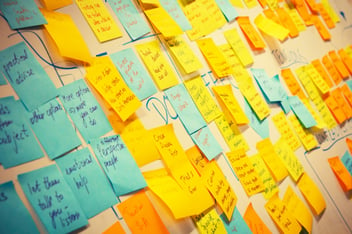
I get to do a lot of interesting stuff for my work with Rewire. For instance, I wrote a few weeks ago about some eye-opening research I was doing on making better decisions. One of the other fun things I get to do with Rewire is design exercises for us to use in workshops, keynotes, retreats, etc., and today’s article is about one such exercise. We’ll talk about: (1) How the exercise is setup, (2) what almost always happens with people as they do this exercise, and (3) what this means for sustainably growing our work.
1. How the exercise is set up.
- Take a group of people (needs to be bigger than 15; less than 100) and split them into two groups.
- Each group is given a brick.
- Both groups get a facilitator to explain a task to them.
- One group gets a positive and engaged leader who tells them that their task is to come up with as many uses as possible for the brick they’ve been given. This leader makes eye contact with their group, encourages collaboration and creativity, and expresses their belief that this group will absolutely nail this task. This leader stays with his or her group for the duration of the exercise. We’ll call this facilitator the “Engaged Leader.”
- The other group gets a disengaged and demotivating leader. We call this facilitator the “Dumpy Leader.” This leader also tells the group that their job is to come up with as many uses for their brick as possible, but with a few differences in the way they communicate:
- They don’t make much, if any, eye contact.
- They stare at their phone the whole time.
- At one point they stop giving instructions to take a brief phone call.
- They also tell the group that this task “is really hard. So don’t be surprised if you don’t come up with too many uses for the brick. I mean, unless you’re like MIT material, it’s really tough.”
- Once Dumpy Leader finishes explaining the task and telling the group how hard it’s going to be, he or she will call their (imaginary) friend back and leave the room.
- Both groups get about 7-10 minutes to come up with as many uses as possible for their brick.
2. What happens with people when we do the exercise
First, it’s important to state that I did not pull this exercise out of thin air, so it’s not like we do this with a group of people without knowing what’s going to happen first. This exercise has been replicated many times as part of the excellent research by Christine Porath and Amir Erez (among others).
- Once the time is up, we have the groups tally up their uses for the brick.
- The group with the more engaged leader always has more ideas for uses for the brick.
- The workshop facilitator then (facetiously) asks “Why it is that one group is obviously smarter and more creative than the other?” (We try to twist the knife just a little to make people feel the exercise more deeply. I know - we’re mean people and ought to be ashamed of this…)
- We have the two groups compare notes of what was the same and different for their work in the exercise with the brick.
- Some groups will try to save face and keep from outing the Dumpy Leader as a dumpy leader, but we push them toward talking about what Dumpy Leader did or didn’t do compared to the Engaged Leader. (Eventually, we’ll tell them that Dumpy Leader was in on it the whole time, so they can say whatever they want about him or her. Then everyone relaxes and just tears Dumpy Leader to shreds!).
3. 3 ways this exercise applies to sustainably growing our work (though I could give 10 more easily)
- No man or woman is an island. At Rewire, we’re big proponents of accountability, personal responsibility and work ethic. But the fact of the matter is that our coworkers and colleagues and organizational culture have a profound impact on our work. The brick exercise gives us a forced choice: either half of the group in the exercise is filled with dim bulbs, or emotions and communication patterns become self-fulfilling prophecies for team performance (And I have yet to hear a group of people admit to being less-intelligent than their workshop mates).
- Leadership has a disproportionately huge impact on setting up teams for success or failure. In the brick exercise, each group (whether it’s 10 people or 50) only has one leader - yet that one leader’s self-presentation and communication patterns pushes their group’s performance one way or the other. So, if you’re a leader of people and interested in the success of your venture, pay close attention to keeping your EQ and communication skills as high as possible. And if you would like some help with that, don’t hesitate to reach out.
- Hire for emotional intelligence, positive collaboration and constructive communication. Sometimes, as leaders, our main question when considering who to bring into our companies is whether or not someone can “do the work.” But, as this exercise demonstrates, our companies and teams would be served better by giving as much attention to how a prospective team member does their work and what impact their presence and communication habits have on those around them. Mindset coaches are excellent at improving how you work and enhancing your the impact your presence has on your co-workers. Think about the "Dumpy Leader": They did communicate the task to their people and facilitate their group's undertaking of the brick exercise. They did the work. But the way in which they did it had a profound impact on the outcomes of everyone they worked with. Which means that it’s not enough for our people to simply “do the work” if their presence and communication puts a drag on the performance of those around them.
What about you? What do you think about the “brick exercise?” What else do you think this exercise shows about the nature of growth in our work? Let me know in the comments!




